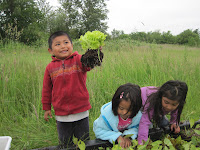The Solstice has arrived and with it no more predictions for rain for the week. The hot June sun is doing its job by warming away threats of precipitation by mid morning each day and sending those clouds up and out of the way. Warmer temps seem to be reaching normal levels ranging from 55-80 during the days. The gardens have shown signs of improvement as well. The tomatoes have greened up and are starting to spread, the peas and greens are growing well. In Silverton, I made another 200 square feet of gardening space by removing sod and planting vetch and grass. Then I hoed out the grass a few months later and double dug the beds to raise them up. I made one long running bed about 25 feet long and 3 feet wide and 5 raised hills for planting my hot crops and storage crops. The soil was workable and next year it will be better because I will use two types of winter cover crops to give the soil good protection and increase the tilth. Linden's garden has been doing better after receiving the most rain of the other gardens (because of its proximity to the coast).
I gained two more centers who are anxious to get gardens started; they are Jose Pedro and Settlemeier. The buzz about these gardens and the activities our children are doing with them has excited centers all over Oregon. My job is looking busier and busier as the gardens warm up and people warm up to the gardens. Yippee! The interesting aspect to these two new centers is that they lack ground space for food production. Each center at OCDC is individual and take on the terms of Head Start in creative ways. It takes time to analyze what would work best for each center. The centers lack gardening space but they will have some grand container gardens. I am great at container gardening. I hope to dot their outdoor space with massive containers full of food that is visually stunning. I hope to create an ornamental look with a food functionality. So...what plants will I be using. Well I will absolutely be using Swiss Chard because it is my favorite plant to grow right now. They might contain Kale, Fava Beans, Winter Peas, Parsley, Leeks, Cilantro, Carrots and Parsnips, cabbage, and broccoli. We will also be planting blueberries in containers. We hope to create a stable container garden practice for each center. I hope that this new garden style will be applicable to our home garden plots as well as our centers who similarly lack safe grounds for food producing. I hope to show our centers and the readers that space is not the biggest limiting factor for gardening among cost, access to water, creativity and time.
The new crop of kids has been fun. They are all sons and daughters of seasonal or migrant workers who have traveled to Oregon for our busy ag season. The ranges of skills and behaviours these children exhibit is wide so the classes have been a bit tougher. I am adapting the teaching style for these classes to be more camp based. There are crafts, story telling, harvesting, etc in shorter and easier to understand segments. This week we will pick a plant and draw it and write a few words about it on some paper. It will become a book of plants for each center to have made by the children and for the children. It will compromise a series of arts, observations, and literacy work for our children. My Spanish has been getting much better. I am able to understand a lot more of what my children mumble and have been able to communicate better with them and our teachers. I have been excited to use my Spanish in each class. I am looking forward to better weather and bigger crops. Good luck in your gardens and classes!
In the photos that precede this post you can see our children at Silverton harvesting some salad. They gave it to their kitchen to cook salad for them today! What a treat for all of us.
How does your garden grow?
TIME TO PROPAGATE YOUR TOMATOES: You like to pull of those "suckers" right? It makes your plant grow stouter and stronger right? Meh...maybe. Don't throw them in the compost. Take your suckers ( at least 2 inch long ones) and propagate them. With the soft start to our summer providing cloudy and humid days, you have got a great climate for producing some more plants. If you get em now, you might be able to pull off some more tomatoes or replace ones beat up by the rains.
Love Lupines: Need a beautiful native perennial that withstands lots of water and a bit of shade? Need one that fixes nitrogen to improve your soil and your plants health? Need one of the first plants to return from the blast zone of St. Helen's 20years ago? LUPINE BABY! Use it, love it, save the seeds and spread it.
Recipe: Chop chard and greens to chip sizes. Chop some of your beets into bite size coins or dice sized cubes. Crumble in some goat cheese, your fave nuts, a little olive oil, and a citrus squeeze. Eat voraciously or not at all.
Need some gardening advice? Post a question to the blog and we will try and answer it for you.
Enjoy the weather and get outside this week--Garden Guru Katz


